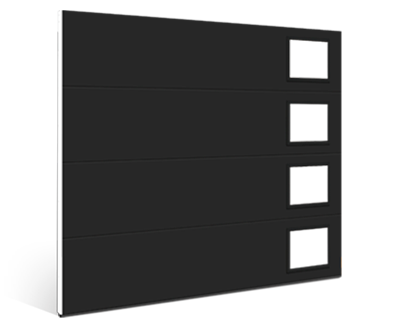Ideal Door Windload
Ideal Door has an easy-to-use product selection guide to identify the appropriate wind load application for each building code jurisdiction. Ideal Door WindCode® garage doors are identified by “W” designations; the higher the “W” rating, the stronger the garage door.
FACTORS TO CONSIDER WHEN CHOOSING A REINFORCED GARAGE DOOR:
- Research the wind load requirements for your geographic region and make sure your garage door meets them. The local building code authority can provide current information and a professional garage door technician can perform an on-site inspection.
- Know your garage door, even if you didn’t buy it. If you have recently moved into a new residence and did not purchase the garage door currently installed on your home, have a garage door professional inspect it to ensure it is the appropriate model for your area. Also, have them demonstrate how to secure the garage door during a storm.
- Understand “Storm Ready™” vs. “add-on” reinforcement.
Two kinds of reinforced garage doors are available in the marketplace. With the “add-on” system, a homeowner must install long posts in the floor and ceiling to reinforce the garage door before the storm hits, and then remove them again afterwards to resume normal operation. Ideal Door’s “Storm Ready™” models require no advance set-up. Reinforcement is contained within the structure of the door and is engaged by simply locking it – a timesaving convenience in the event of an evacuation notice or unexpected high wind event. This type of garage door is particularly beneficial to vacation home and rental property owners because they have peace of mind knowing that the garage door is secure as long as it’s locked. - Retrofitting an older garage door with new hardware will not provide the structural support needed for the new building codes.
- You can have safety in style. A reinforced garage door doesn’t necessarily mean barricading the garage opening in a solid sea of steel. Ideal Door offers code-compliant carriage-house style garage doors and impact resistant windows.
- Style inside and out! – Ideal Door is converting doors to our newly patented Tapered Strut or “T-Strut” design. This design is cleaner, less bulky and easier to install than previous technologies.
Storm Ready™ – Ideal Door’s doors are ready for the storm. Simply close and lock your door! No need to install a post or pins. This is not only a time saver, but could be a life and home saver if an unexpected wind even occurs.
DETERMINE YOUR WINDCODE® DOOR RATING
Ideal Door assigns a WindCode® Door “W” rating to our doors based on code requirements determined by wind speed in miles per hour (MPH), home exposure and home structural type.
STEP 1:
Determine the minimum wind speed (MPH) your door must meet or exceed from the map. This map is to help determine your “W” rating, and should be used as a guideline only. Contact your local building code official to determine the proper wind load requirements in your area.
STEP 2:
Determine if your home is in an Exposure B or Exposure C region.
Exposure B – typically urban or suburban setting or wooded terrain.
Exposure C – open terrain with scattered obstructions, flat open ground, grasslands or shorelines in hurricane-prone regions.
STEP 3:
Determine the structural type of your home.
Due to the complexity of installing WindCode garage doors, meeting codes and pulling permits, we highly recommend professional installation.
Using wind speed (MPH), exposure and structural type, find your required design pressure and WindCode® door “W” rating in the charts below.
Note: It is important to also contact your homeowner’s insurance company. Many insurance companies may require or encourage doors that are different than required by building code.
DESIGN PRESSURES
The design wind load pressure rating of a door is expressed in PSF (pounds per square foot). The design pressure of the door must equal or exceed the design pressure for the garage door opening in which a door is to be installed. Design pressure has positive and negative values.
WINDCODE® DOOR RELATED TERMS
ASTM E330
The testing standard used in the garage door industry. Also known as uniform static air pressure testing. This standard was developed by the American Society for Testing and Materials (ASTM) to allow products to be measured in air pressure chambers. ASCE7 Design standard developed by the American Society of Civil Engineers titled “Minimum Design Loads for Buildings and Other Structures”. Section 6 of this standard deals with wind loads.
ASCE7
Is the basis for wind load calculations used in most building codes.
International Building Code
Model building code developed by the International Code Council. Most of the U.S. has adopted this building code (sometimes with slight, locally adopted variations). The wind load provisions in this code specifically call out ASCE7 to be used in wind load calculations.
Design Pressure
The measurement of resistance in both positive and negative directions that a garage door system must withstand. Design pressures are usually expressed in both positive (PSF+) and negative (PSF-) values. Also known as design load.
Test Pressure
The actual tested wind pressure resistance that a garage door system will withstand during laboratory testing. Most building officials require that the test pressure be equal to 150% of the design pressure. Also known as test load.
Three-Second Gust
How wind is measured by the National Weather Service. This data is then compiled into wind maps incorporated into ASCE7 and the International Building Code. The wind speed maps are based on a yearly 2% probability of occurrence (50-year average peak wind).
Mean Roof Height
The height above grade level of the midpoint of the roof. Mean roof height is calculated by averaging the eave and ridge heights, and is used as part of design pressure calculations in both ASCE7 and the International Building Code.
Wind Velocity
The actual measured speed of airflow during a wind event; usually expressed in MPH. Wind velocity is typically measured at 33 feet (10 meters) above ground level at airports and similar open country locations.
WindCode®
The registered name for all Ideal Door garage door products designed and tested to comply with wind resistance requirements of local, state, and national building codes. The WindCode® program includes engineering, marketing and sales programs designed to help Ideal Door customers understand code issues and determine the best garage doors for their specific geographic area.





